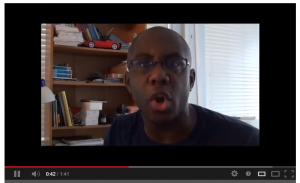David Rose is my guest blogger. I thought as an angel investor, he has some valuable tips for entrepreneurs who want to successfully pitch to investors. By David S. Rose / January 19th, 2014
I’ve written on this topic previously, including David S. Rose’s answer to Startups: What is the worst startup pitch ever? While I’ve never laughed outright during a pitch, I’ve certainly had quite a few occasions where I had to work hard not to wince. The problems with bad pitches tend to fall into the following major categories:
- The content is just bad, off-base or not thought-through
- Slides or other visuals are poorly executed, amateurish, confusing and counter-productive
- The presenter is not a naturally talented speaker, has never been taught how to present, and/or hasn’t practiced the presentation
Blowing only one of the three generally merits the presenter at least a respectful response and discussion (although if it’s a case of #1, then there obviously will not be an investment.) The problem comes when someone blows two, or even all three. That’s when it gets really wince-worthy and painful for the audience. As an example, take a look at this presentation, which is really pretty bad across the board:
As for embarrassing moments, the one that takes the cake was several years ago when an attractive woman CEO was pitching to a group I was in, and during the presentation she accidentally knocked off her own hairpiece. To her credit, she smoothly continued as if nothing had happened, and eventually got the investment! What was interesting was that (a) it was a small hairpiece, (b) it was at the back of her head, and (c) guys are notoriously unobservant, so because she handled it so professionally…the majority of men in the room were not aware of the mishap!
*original post can be found on Quora @ http://www.quora.com/David-S-Rose/answers *


 Facebook has launched video advertising reports the
Facebook has launched video advertising reports the  Jim Cathcart, motivational speaker and author of the
Jim Cathcart, motivational speaker and author of the For years I've been saying that speakers will need broadcasting skills. Well, the future is now. Recently, I was asked to do a
For years I've been saying that speakers will need broadcasting skills. Well, the future is now. Recently, I was asked to do a  How do public speakers go from good to great to awesome? They attend the NYC chapter of the National Speakers Association. The guest speaker for November was executive speech coach,
How do public speakers go from good to great to awesome? They attend the NYC chapter of the National Speakers Association. The guest speaker for November was executive speech coach,  On Monday, I decided to try a test. I declared my intention that I was going to book business on that day. I didn't know how. I didn't know where it would come from. I didn't start calling a list of numbers. By late afternoon, I went to my inbox and there was an email. It said, "Could you send us dates when you are available?"
On Monday, I decided to try a test. I declared my intention that I was going to book business on that day. I didn't know how. I didn't know where it would come from. I didn't start calling a list of numbers. By late afternoon, I went to my inbox and there was an email. It said, "Could you send us dates when you are available?"
 Don't let your head be on the chopping block. Keep abreast of these three public speaking trends and your audience will gobble up your ideas.
Don't let your head be on the chopping block. Keep abreast of these three public speaking trends and your audience will gobble up your ideas.
 Do you want to be an exceptional speaker? My friends Alan Stevens and Paul Du Toit, from the U.K. have just published a book that shows you how. I saw them at the
Do you want to be an exceptional speaker? My friends Alan Stevens and Paul Du Toit, from the U.K. have just published a book that shows you how. I saw them at the  How did a college intern trump me in public speaking?
My marketing intern from Berkley College in New York City is from Korea and she is studying marketing as well as working on her English language skills. That was one of the reasons she was interested in interning with
How did a college intern trump me in public speaking?
My marketing intern from Berkley College in New York City is from Korea and she is studying marketing as well as working on her English language skills. That was one of the reasons she was interested in interning with  On Saturday, October 19, I spoke at the WPIX, Channel 11
On Saturday, October 19, I spoke at the WPIX, Channel 11 

 New York, NY (October 10, 2013) – Diane DiResta, Founder of
New York, NY (October 10, 2013) – Diane DiResta, Founder of 






 There's a line from a World War I song:
"How you gonna keep 'em down on the farm
After they've seen Paris?"
There's a line from a World War I song:
"How you gonna keep 'em down on the farm
After they've seen Paris?"